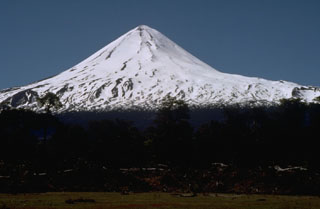Report on Llaima (Chile) — 6 February-12 February 2008
Smithsonian Institution / US Geological Survey
Weekly Volcanic Activity Report, 6 February-12 February 2008
Managing Editor: Sally Sennert.
Please cite this report as:
Global Volcanism Program, 2008. Report on Llaima (Chile) (Sennert, S, ed.). Weekly Volcanic Activity Report, 6 February-12 February 2008. Smithsonian Institution and US Geological Survey.
Llaima
Chile
38.692°S, 71.729°W; summit elev. 3125 m
All times are local (unless otherwise noted)
SERNAGEOMIN reported intense Strombolian activity in the main crater of Llaima and explosions that propelled material 500 m in the air on 6 February. Ash-and-gas plumes from the activity rose to altitudes of 5.1-5.6 km (16,700-18,400 ft) a.s.l. and drifted SE more than 30 km. Multiple lava flows traveled 0.7-1.5 km W and N and generated steam plumes due to their interaction with a glacier. Activity declined later that day. During breaks in cloud cover, ash plumes were observed at altitudes of 4.1-9.1 km (13,500-29,900 ft) a.s.l. and drifted NW. During 7-8 February, explosions from two different areas in the main crater produced brown and gray ash-and-gas plumes that rose to altitudes of 4.1-6.2 km (13,500-20,300 ft) a.s.l. and drifted 20 km NW. Incandescent blocks from lava-flow fronts rolled down the flank.
According to a news article on 7 and 12 February, people from two communities were evacuated, but were allowed to return to their homes during the daytime.
The Buenos Aires VAAC reported that ash plumes at altitudes of 1.2-3.6 km (4,000-11,800 ft) a.s.l. were visible on satellite imagery during 10-12 February.
Geological Summary. Llaima, one of Chile's largest and most active volcanoes, contains two main historically active craters, one at the summit and the other, Pichillaima, to the SE. The massive, dominantly basaltic-to-andesitic, stratovolcano has a volume of 400 km3. A Holocene edifice built primarily of accumulated lava flows was constructed over an 8-km-wide caldera that formed about 13,200 years ago, following the eruption of the 24 km3 Curacautín Ignimbrite. More than 40 scoria cones dot the volcano's flanks. Following the end of an explosive stage about 7200 years ago, construction of the present edifice began, characterized by Strombolian, Hawaiian, and infrequent subplinian eruptions. Frequent moderate explosive eruptions with occasional lava flows have been recorded since the 17th century.
Sources: Servicio Nacional de Geología y Minería (SERNAGEOMIN), El Mostrador, 123.cl, Buenos Aires Volcanic Ash Advisory Center (VAAC)

